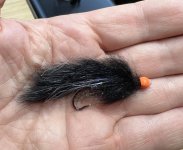Justin Whitlock
Steelhead
So I am beginning to get into swinging flies for steelhead.. could you guys give me any recommendations for some good go to flies? Not asking for your "secret" fly.. just some basics. Appreciate it fellas!
ThisWinter:
String leach on a tube
Any type of marabou fly
Summer:
Green but skunk
Purple Peril
Muddler
That's a really solid top 3 for summer.Winter:
String leach on a tube
Any type of marabou fly
Summer:
Green but skunk
Purple Peril
Muddler
Same type of muddler you’d use for Cutthroat?Winter:
String leach on a tube
Any type of marabou fly
Summer:
Green but skunk
Purple Peril
Muddler
I'm curious about what you mean by this. We are, after all, talking about flies for a fish known to rise to cigarette butts and filters. Is the difference in regards to aesthetics and eye appeal to the angler? Or functional differences, like not tying a bucktail wing longer than the bend of the hook so as to prevent it from twisting around the hook? Or that steelhead accept and reject fly offferings based on construction methods and proportions of body to tail and or wing?study construction and proportion. Makes all the difference
I agree. In my personal experience, it's usually about annoying/antagonizing them into biting.I'm curious about what you mean by this. We are, after all, talking about flies for a fish known to rise to cigarette butts and filters. Is the difference in regards to aesthetics and eye appeal to the angler? Or functional differences, like not tying a bucktail wing longer than the bend of the hook so as to prevent it from twisting around the hook? Or that steelhead accept and reject fly offferings based on construction methods and proportions of body to tail and or wing?
When I first began fly fishing for steelhead I thought I had to tie flies using the exact same materials tied in the exact same proportions as my study flies, or the steelhead would not bite the fly I presented them. I couldn't have been more wrong. When I noticed that bait anglers were catching steelhead with a piece of red or orange yarn on a hook, I re-thought my approach to tying steelhead flies. Now you have me wondering 50 years later if I was missing something.

Mid-March on an upper OP river I hiked into the head of a newly created run. There was a deep, soft eddy in front of me with the main current seam 20' out. A white movement caught my eye in the pool. As I stood still I realized that it was a very big colored up male steelhead with some mold on it's back. Motionless, I watched it swim in and out of vision for several minutes. Then it came up to the surface 6' in front of me to swirl at a small piece of wood floating in the current.I'm curious about what you mean by this. We are, after all, talking about flies for a fish known to rise to cigarette butts and filters. Is the difference in regards to aesthetics and eye appeal to the angler? Or functional differences, like not tying a bucktail wing longer than the bend of the hook so as to prevent it from twisting around the hook? Or that steelhead accept and reject fly offferings based on construction methods and proportions of body to tail and or wing?
When I first began fly fishing for steelhead I thought I had to tie flies using the exact same materials tied in the exact same proportions as my study flies, or the steelhead would not bite the fly I presented them. I couldn't have been more wrong. When I noticed that bait anglers were catching steelhead with a piece of red or orange yarn on a hook, I re-thought my approach to tying steelhead flies. Now you have me wondering 50 years later if I was missing something.